Introduction
The calculation of the amount of fuel required for an aircraft is not left to chance and is one of the most crucial tasks in the preparation of the flight.ol.
It is, of course, a matter of loading enough fuel to operate safely while optimising its carriage to take only the necessary amount on board. Indeed, fuel is also a weight to be carried, and therefore impacts the aircraft's performance and operational costs. The art of fuel policy lies in anticipating unforeseen circumstances while remaining economically and environmentally efficient..
To this end, EASA, the European Union Aviation Safety Agency, has defined a calculation plan outlining the legal minimum fuel for planning: the Fuel/Energy Scheme defined in the Air Operations document. The regulations provide for differences according to aircraft classes and the type of operation..
Firstly, here are the definitions of the main concepts used :
Minimum fuel required : Minimum amount of fuel that must legally be on board during a given phase of flight.
Block fuel / Ramp fuel : Quantity of fuel on board at engine start.
Taxi fuel : Fuel required for engine start-up (and for the use of the APU if applicable), and for taxiing to the runway.
Take Off fuel : Amount of fuel on board before take-off.
Trip fuel : Fuel required for take-off, climb, cruise, descent, approach, and landing.
Contingency fuel : Route reserve increasing the Trip Fuel to cover unforeseen circumstances that increase fuel consumption (winds, road conditions, air traffic, etc.).
Alternate fuel : Fuel required for the alternate aerodrome from the destination in case of diversion.
Final reserve fuel (FRF) : Minimum fuel quantity required to be on board during flight.
Additional fuel : Additional fuel required when the most critical scenario (critical fuel scenario) demands an amount of fuel greater than the minimum required.
Extra fuel : Additional fuel required for anticipated technical constraints.
Discretionary fuel : Additional fuel at the direction of the captain.
Commercial Operations Basic- CAT.OP.MPA.181
In the context of commercial flights, the minimum fuel quantity is defined according to the following method based on the aircraft class:
Basic fuel scheme – Class A aircrafts*
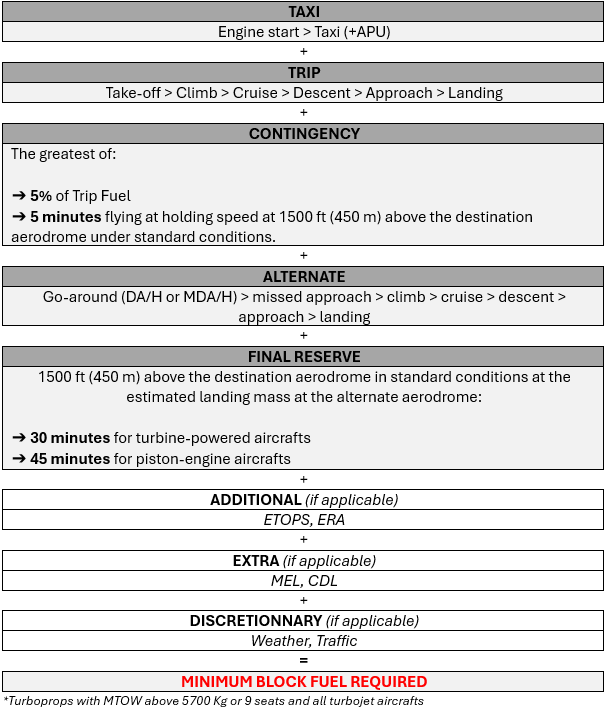
Basic Fuel Scheme – Class B* et C** aircrafts
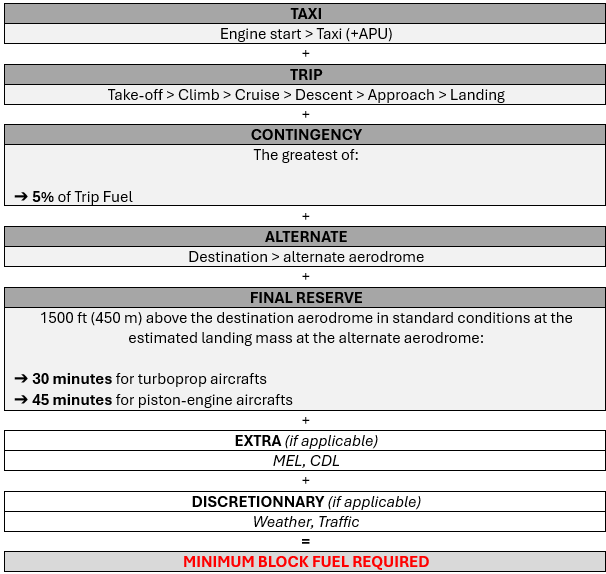
Local flight - ELA2* aircraft
In the case of a local VFR flight during the day, the final reserve fuel must not be less than 45 minutes of flight.
*European Light Aircraft – moins de 2000kg non-complexe
Commercial Operations with variations
The regulations provide for exemptions to the basic calculation under certain operational and legal conditions in order to reduce the minimum required amount of fuel.:
Contingency fuel
The contingency fuel can be reduced using the following two methods :
- ERA :

The selection of an alternate aerodrome en route is subject to the legal weather minima for an alternate, as well as to location criteria as demonstrated below.:
The alternate aerodrome must be located within a radius centred on a point of the route corresponding to 25% of the total flight distance from the destination aerodrome OR 20% + 50 nm (whichever is the higher of the two).
- RCF :
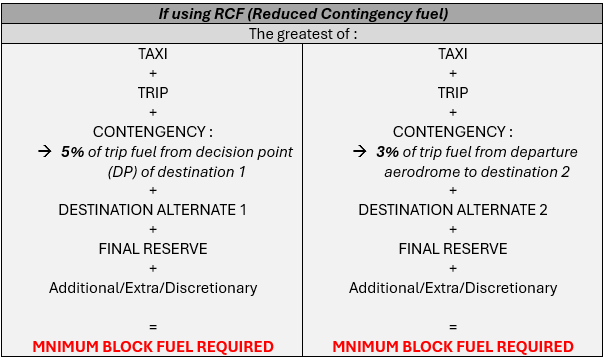
This method involves determining a decision point (DP) on the route and planning a second destination to allow for a reduction in the contingency fuel.
At the crossing of the DP, if the fuel on board is insufficient to reach the initial destination (destination 1), the pilot must divert to the second destination (destination 2).
No alternate
It is possible not to include alternate fuel on the following conditions :
- Flight duration of less than 6 hours (or 4 hours in the case of RCF)
- 2 separate runways
- Weather :
- Ceiling above 2000 ft (600m) or circling above 500 ft (150m)
- Visibility greater than 5 km
Isolated aerodrome
A destination aerodrome is considered isolated if the sum of the diversion fuel and the final reserve required to reach the nearest diversion airport is greater than:
- 45 minutes + 15% of the planned cruise flight time or 2 hours (whichever is greater) for piston aircraft.
- 2 hours at normal cruising speed above the destination airfield for turboprop/jet aircraft.
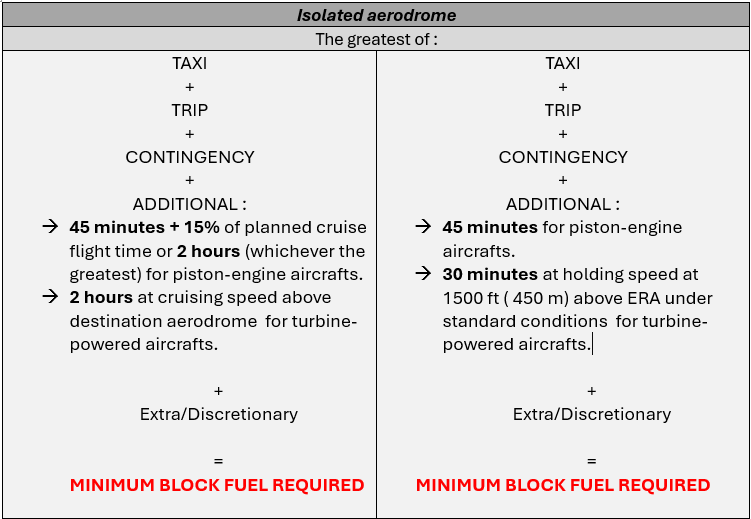
Non-commercial Operations - NCO.OP.125
For non-commercial flights operated on non-complex aircraft, the regulations do not specify a precise fuel planning requirement but merely require a final reserve to be on board under all circumstances. :

Non-commercial operations Complex Aircraft - NCC.OP.131
Is defined as complex the aircraft meeting the following criteria :
- A maximum certified take-off mass exceeding 5700 kg.
- A capacity of more than 19 seats.
- Certified for operations with a minimum of 2 pilots.
- Equipped with turbojet engines or more than 2 turboprop engines.
In certain cases (ferry flights, private transport), these aircraft, when called to operate without an air operator certificate (AOC), are subject to specific regulations.
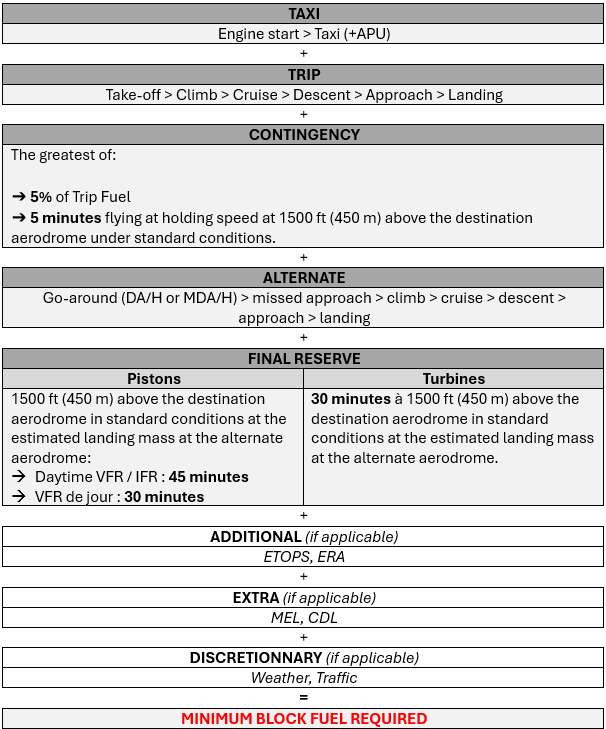
Variations :
- Reduced contingency fuel: not applicable in the case of non-commercial operations.
- Isolated aerodrome : rules identical to those of commercial operations.
References
-The EASA document regarding the implementation of the new regulation.
-The complete Air Operations document published by EASA.